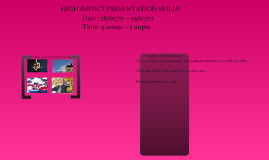High Impact
Transcript: High Impact Impact of Pop Culture on Society's Understanding of what it means to be Queer in the 21st Century Interactive Activity History 1930 1980 1950 1920 1970 1990 Music Movies Television Movies TV becomes mainstream no representation Movies queer characters as villains - Caged (1950) queer-coding sissy trope Hays Code ruled unconstitutional homosexuality as a source of humor - The Florida Enchantment (1914) - Wanderer of the Ranch (1927) freedom of expression lesbian prison guard in Caged Hays Code Morocco (1930) Queen Christina (1934) Music Wings (1927) 19th century jazz musicians - Tony Jackson - Bessie Smith - Ma Rainey - Lucille Bogan Bessie Smith, nicknamed the "Empress of Blues" queer artists in other genres Esquerita (rock) Billy Tipton (jazz) Charlie and Ray (R&B) Charlie and Ray Marlene Dietrich in Morocco Esquerita TV 1971: All in the Family 1977: Soap, The Jeffersons Movies Gay characters begin to acquire more depth and self-awareness Music Music TV disco culture sexual liberation movement Elton John, Queen, David Bowie, Grace Jones increased exposure to gender-bending and cross dressing Erasure, Frankie Goes to Hollywood, Pet Shop Boys, Culture Club, etc. Billy Crystal as Jodie Dallas in Soap representation picks up speed Tales of the City, Ellen, Will & Grace Music rise in pro-LGBT legislation more artists condemning homophobia Placebo, Alcazar, Mana "queercore" punk bands - Pansy Division - Tribe 8 Grace Jones Culture Club Tribe 8 performing Ellen DeGeneres coming out on her sitcom in 1997 Modern Representation Consumption: The average american watches more than 4 hours of TV a day Representation: Characters that identify as queer and are portraying queerness Tokenization: Taking one individuals experience and applying it to every member of that group Present Good Representation - natural lgbtq relationship -part of the story/not a big dramatic moment -humane/lgbtq character has an actual life outside of being queer -relationship is explicitly intimate Representation + Consequences No Representation -movie production doesnt include lgbtq stories at all Bad Representation - perpetuates tropes - only point of character is their queerness -character dies off -Queer Baiting -having characters that are straight but have "gay moments" that are never explored or strung out beyond the moment Movies+TV Pose Sassy Black Trans Woman The Circle Token Gay Man/Best-friend Moonlight Euphoria Queer Music Icons KEHLANI - everything in her life is projected and analyzed -heavily sexualized -token/example/role model Music LIL NAS X - heavily scrutinized -becomes his identity and selling point Consumption + Creation Social Media Consumption - Daily representation of "queerness" -Hey mamas -masculine lesbians -perpetuating steryotypes Creation - "and I can't change" trend -but when she loves me trend -we get to create the narriative Greater Impact Personal Impact Idolization encourages the presence of LGBTQIA role models Reflects acceptance and tolerance in our own lives Guiding forces Statistical improvements in acceptance towards queerness Potential to reinforce harmful stereotypes about what queerness looks like Importance of representation Impact Demonstrates how non-queer folks can act as a support system Yet, according to some, this normalizes an unnatural and risky lifestyle Impact Allies on society's understanding of what it means to be queer in the 21st Century Questions & Reflection journal, draw, mind-map & be prepared to share some ideas Questions & Reflection Self Society What is pop culture's role/responsibility in representing the LGBTQ+ community? Has pop culture contributed to a negative or positive societal view of the LGBTQ+ community? Has pop culture influenced your relationship and or understanding of your own sexuality? If so, in what way? Do you feel your own sexuality is and has been accurately depicted in pop culture? How or how not?

















